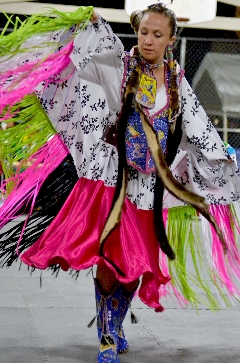
IRIS login | Reed College home Volume 96, No. 2: June 2017
"Invisible" Indians Converge on Campus
The thunder of drums and the syncopated chant of voices echoed through Eliot Chapel last month when traditional dancers swept a captivated audience of students and faculty into a culture, a community--even a world--often overlooked by those outside of it: the Native American community.
The dance introduced Reed's fifth annual Vine Deloria lecture, a panel discussion titled "Making the Visible Invisible," referring to the striking fact that Portland has the ninth largest Native American population in the United States, including more than 20,000 residents drawn from 380 different tribes, according to a recent report titled "The Native American Community in Multnomah County: An Unsettling Profile," released by the Coalition of Communities of Color and PSU.The panel discussion served as a powerful counterpoint to the energy and brightness of the dance, and presented a sobering portrait of prejudice, racism, and repeated attempts by mainstream culture to define Indians out of existence.
The panel was composed of experts on Native American culture: Nichole Maher of the Tlingit tribe, executive director of Native American Youth & Family Center (NAYA), an advocacy group based in Portland; Matt Morton of the Squaxin Island tribe, deputy executive director NAYA) Laura Harris of the Comanche tribe, CEO and executive director of Americans for Indian Opportunity; and Sherry Addis of the Confederated Tribes of Siletz, who supervises those tribes' Portland area office.
Morton, who moderated the discussion, introduced the report alongside questions for his colleagues: What are the most pressing problems affecting the local Native American community? Why are these problems so prevalent? Why do they continue to persist? The panel agreed that certain problems consistently plague the community: high poverty levels, poor child welfare, low graduation rates, and poor health care coverage. "Natives count disproportionately among the poor and impoverished," Maher said. "They have the high rates of homeless and poverty among minorities," alongside extraordinarily high rates of depression, addiction, and diabetes.
Nonetheless, the panel unanimously and wholeheartedly agreed that the real problem was the "invisibility," or lack of public recognition of the Native American community. Because Indians have been systematically undercounted, the panel argued, their problems have been ignored and resources have not been equitably distributed to them, leading to continued neglect.
"Public perception informs policy," said Addis. "And because of it, our children are in foster care, cannot graduate on time, and have trouble getting jobs."
So how does one, then, go about making the invisible visible? The panel suggested that Native Americans share their community with Portland; that both communities must work together until they achieve mutual understanding.
"Until then," one panel member quipped, "nothing is going to happen."
The event was sponsored by Reed's Multicultural Resource Center in conjunction with the Native American Youth and Family Center. The lecture series honors Vine Deloria Jr., one of the preeminent intellectuals of the 20th century, whose work brought attention to the importance of place and traditions within Native American communities.
Tags: alumni, census, deloria, diversity, Native Americans



LATEST COMMENTS
steve-jobs-1976 I knew Steve Jobs when he was on the second floor of Quincy. (Fall...
Utnapishtim - 2 weeks ago
Prof. Mason Drukman [political science 1964–70] This is gold, pure gold. God bless, Prof. Drukman.
puredog - 1 month ago
virginia-davis-1965 Such a good friend & compatriot in the day of Satyricon...
czarchasm - 4 months ago
John Peara Baba 1990 John died of a broken heart from losing his mom and then his...
kodachrome - 7 months ago
Carol Sawyer 1962 Who wrote this obit? I'm writing something about Carol Sawyer...
MsLaurie Pepper - 8 months ago
William W. Wissman MAT 1969 ...and THREE sisters. Sabra, the oldest, Mary, the middle, and...
riclf - 10 months ago